Smt. S. S. Patil College of Pharmacy, Chopda 425107, North Maharashtra University, Jalgaon, Maharashtra, India.
Abstract: Curcuma caesia is commonly known as kali haldi and it belongs to the family Zingiberaceae. This herb is available throughout in India it is found in West Bengal, Madhya Pradesh, Orissa, Chhattisgarh, and Uttar Pradesh states. In the traditional system of medicine, fresh and dried rhizomes of Curcuma caesia Roxb are used in treating leucoderma, asthma, tumours, piles, bronchitis, bruises, etc. The aim of this study was to evaluate phytochemical constituent of Curcuma caesia Roxb rhizomes. Preliminary phytochemical studies investigated the presence of abundance of volatile oil, phenol, flavonoids, alkaloids and proteins in Curcuma caesia rhizomes. Present communication deals with the detailed pharmacognostical evaluation of the Curcuma caesia rhizomes.
Keywords: Curcuma caesia, transverse section, volatile oil, phenol, flavonoids, alkaloids.
Curcuma caesia Roxb is a member of the family Zingiberaceae and popularly known as Kali haldi. In India it is found in West Bengal, Madhya Pradesh, Orissa, Chhattisgarh, and Uttar Pradesh states. It nourishes well in moist deciduous forest areas.[1] Rhizomes of the plant are used for sprains and bruises and also employed in the preparation of cosmetics.[2] The effective use of Curcuma longa Linn. well known since a long time; it is laxative, anthelmintic, and vulnerary, besides this it is used in blood disorders, leukoderma, scabies, small-pox, and sprains. Curcuma amada Roxb is useful in bronchitis, asthma, sprains, skin diseases, and in ammation caused due to injuries.[3] The genus Curcuma is a well-known spice of India. It is also called Haldi and more than 200 species and subspecies of it is found all across the world. One of which is Curcuma caesia Family: Zingiberaceae. It is also known as “Kali Haldi.” It is an erect rhizomatous herb with large leaves. Fresh rhizomes are aromatic with intense camphoraceous odour and are applied externally to sprain and bruises.[4] Black Turmeric (Curcuma caesia) is native to North-East and Central India. It is also sparsely found in Papi hills of East Godavari, the root hills of the Himalayas and North Hill forest of Sikkim. The rhizomes of Black Turmeric have a high economic importance owing to its putative medicinal properties. The rhizomes are used in the treatment of hemorrhoids, leprosy, asthma, cancer, epilepsy, fever, wound, vomiting, menstrual disorder, smooth muscle relaxant activity, anthelmintic, aphrodisiac, inflammation, gonorrheal discharges, etc.[5]-[6] Almost all species of Curcuma contains antioxidant activity and the pharmacological effects and prospects for future clinical use had been tried so far.[7]
Rhizomes of Curcuma caesia were collected in Feb 2012, from Botanical Garden (Zinger Villa) Calicut University, Calicut (Kerala, India), and the plant was authenticated by Professor Dr. M. Sabu, Head, Department of Botany, Calicut University, Calicut (Kerala, India). A voucher specimen (PAR 14) was deposited in the herbarium for further use.
Dried and coarsely powder of Curcuma caesia rhizomes (100 g) was defatted with petroleum ether and the marc remaining was extracted successively by petroleum ether, ethanol and water in different Soxhlet extractor. Solvent was evaporated in rotary evaporator under reduced pressure.
In different parts of India Curcuma caesia is known by different names: Hindi: Kali Haldi, Nar Kachura Krishna Kedar Marathi: Kali-halad Manipuri: Yaingang Amuba or Yaimu Telugu: Nalla Pasupu Kannada: Kariarishina, Naru Kachora Bengali: Kala Haldi Mizo: Aihang, Ailaihang Assamese: Kala Haladhi Nepalese: Kaalo Haledo.
Rhizome large, 5-6 × 9-10 cm, (Photograph 1) blue in the centre, verging towards grey, the blue colour is highly variable, depending upon the nature of the soil and age of the rhizome, strongly aromatic; sessile tubers branched, condensed; roots fleshy; root tubers many, ovate oblong, pale, watery pearl colour. Plants large, 70-100 cm tall, pseudo stem 30-35 cm tall, sheaths green. Leaves distichous, (Photograph 2) 79- 100 cm; petiole as long as lamina; lamina 30-40 × 10- 12 cm, oblong lanceolate, tip acute, base acuminate, glabrous, purple or reddish brown patch along the sides on the distal half of the mid rib on upper side only, fading at maturity, groove of the midrib green. Inflorescence lateral, 25-30 cm long, peduncle 12-18 cm; spike 12-15 × 5 cm; coma bracts large, pink to violet, lower ones streaked green. Fertile bracts 18- 20, 4.5-5 × 4.4-5 cm, lower half used, tip rounded, green with pink tip, each bract subtends a cincinnus of 8-10 flowers. Bracteoles large, 3.5-2.5 cm, white with medium light green patch. Flowers 4.5-5 cm (Photograph 3) equal to slightly shorter than bracts. Calyx 1 cm, truncate, 3 lobed at apex, split on one sight. Corolla tube 3-3.3 cm long, pink, lobes eneqaual; dorsal lobes 1.5 × 1.2 cm, concave, hooded; lateral lobes 1.5 × 1 cm, tip rounded, pink. Labellum 1.5-1.7 × 1.8 cm, tip emarginated, yellow with deep yellow median band. Lateral staminodes 1.5 × 1 cm, yellow. Anther 7 mm long, without crest, spurred at base, spurs 3 mm long, divergent. Epigynous gland two, 5 cm long, linear, yellowish green. Ovary 5 mm, trilocular, with many ovules. Style long, filiform; stigma bilipped, slightly exserted above the anther lobes. Fruiting not common.[8]
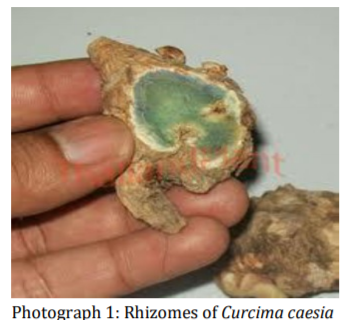
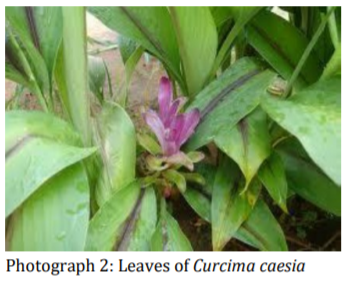
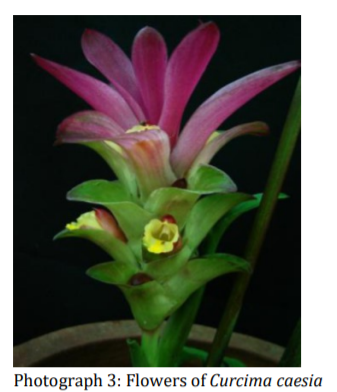
Native to Myanmar, It is also reported from Java and widely cultivated in Malaysia. The Present collection from south India forms the first record from India. It is also wild in south India.[8]
It is very common throughout the coastal areas and riverine alluvial soils extending upto midlands in Kerala and south Karnataka. During mansoon it is common undergrowth in coconut and arecanut groves also as a weed in waste lands in association with Curcuma raktakanta.[8]
April-May (Just after first pre-mansoon showers).

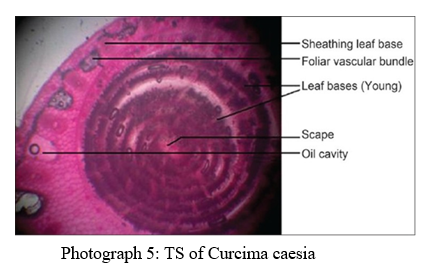
TS of rhizome (Photograph 4 & 5) triangular to circular, it consists of 1. Epidermis: single layered composed of very thick wall cells, covered with thick cuticle 2. Cortex: three to five layered, thick walled collenchymatous cells 3. Endodermis: ill developed 4. Pericycle: well-defined cells radially and compactly placed 5. Pith: large parenchymatous, a large number of cells are filled either with starch grains or sphaeraphides, a number of vascular traces traverse in the pith may be leaf traces 6. Vascular tissue: vascular bundles are conjoint and scattered; xylem consists of vessels and xylem parenchyma. Phloem composed of sieve tubes phloem parenchyma Transverse section (TS) of rhizome is almost circular in outline. Epidermal cells are rectangular-oval in shape and covered with thick cuticle. Long unicellular trichomes are present on the epidermis. Followed to these, 6 to 8 layered storied suberized cork cells are present. A wide cortex having irregularly scattered vascular bundles are present. Each vascular bundle is enclosed within a prominent fibrous sheath, inner limit of cortex marked by endodermis, and pericycle followed by vascular bundles which are devoid of bundle sheath, arranged in a ring; numerous resin cells with their dusky orange colored content are present in cortical region. Most of the parenchymatous cells are filled with starch grains, which are oval-ellipsoidal in shape. Vascular bundles in the central cylinder are similar to those found in the cortex and are scattered, closed, and collateral surrounded by thick walled bundle sheath. Secondary wall thickening reticulate, fibres thin walled with lignified narrow central lumen (Plate-1). In transverse longitudinal section (TLS), cortical cells irregular in shape with variable size. Vessels elongated with spiral and scalariform thickenings and with no clear end-walls. Tracheids with bordered pits are observed.
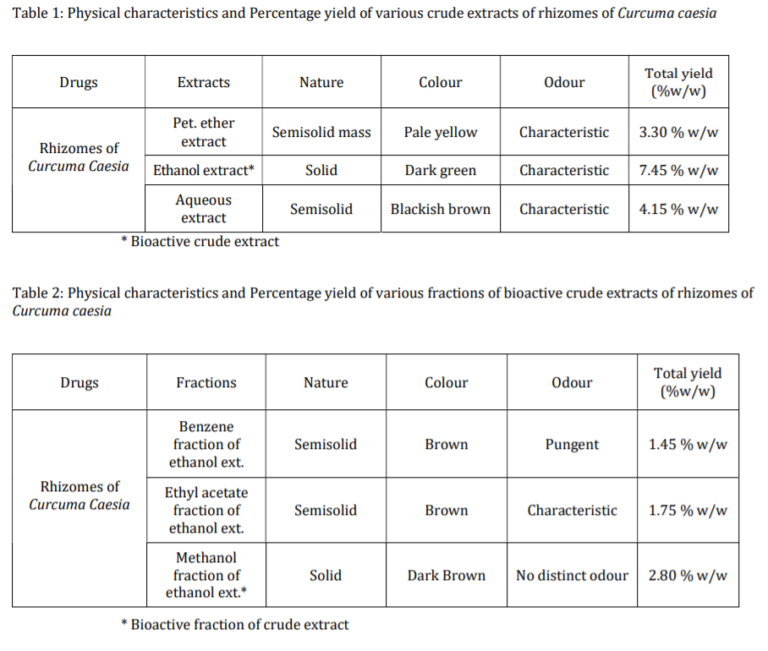
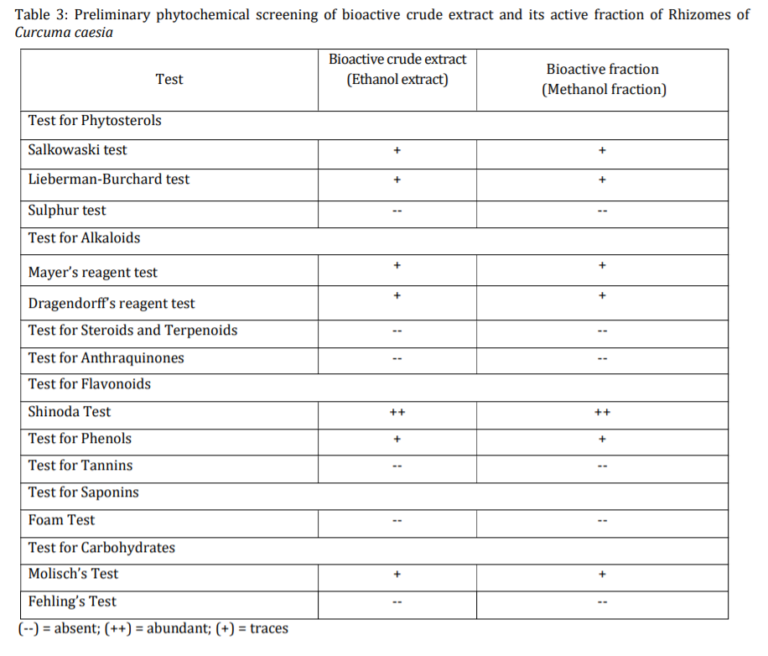
Further rhizomes of Curcuma caesia (Photograph 1) was observed for morphology and as well investigated microscopically. Rhizome large, 5-6 × 9- 10 cm, blue in the centre, verging towards grey, the blue colour is highly variable, depending upon the nature of the soil and age of the rhizome, strongly aromatic; sessile tubers branched, condensed; roots fleshy; root tubers many, ovate oblong, pale, watery pearl colour. TS of rhizome (Photograph 4) triangular to circular, it consists of Epidermis which was single layered composed of very thick wall cells, covered with thick cuticle, Cortex three to five layered, thick walled collenchymatous cells, Endodermis ill developed, Pericycle was well-defined cells radially and compactly Placed, Pith was large parenchymatous, a large number of cells are filled either with starch grains or sphaeraphides, a number of vascular traces traverse in the pith may be leaf traces, Vascular tissue was vascular bundles are conjoint and scattered, xylem consists of vessels and xylem parenchyma. Phloem composed of sieve tubes phloem parenchyma. Petroleum ether extract of rhizomes of Curcuma caesia (table 1) was pale yellow semisolid mass of yield 3.30 % w/w, ethanol extract was dark green solid with yield of 7.45 % w/w. Average expected yield of 4.15 % w/w obtained with aqueous extract which was blackish brown semisolid mass. Benzene fraction of bioactive ethanol extract (table 2) yielded 1.45 % w/w of brown semisolid mass; also ethyl acetate fraction of bioactive ethanol extract yielded 1.75 % w/w of semisolid brown mass. Its methanol fraction of bioactive ethanol extract yield was found to be 2.80 % w/w which was dark brown colour solid. Both the bio-active crude ethanol extract and bio-active methanol fraction shows (table 3) abundance of volatile oil, phenol, flavonoids, alkaloids and proteins.
References
- 1.Nadkarni K M, Indian Material Medica. Vol.1 Bombay: Popular Prakashan; p. 414, 1976. [Google Scholar] [PubMed]
- 2.Anonymous, The wealth of India. Vol.2 New Delhi: Council of Scientifi c and Industrial Research; p. 264, 2001. [Google Scholar] [PubMed]
- 3.Kirtikar K R, Basu R D. Indian Medicinal Plants. Dehradun: International book distributors; p. 2418-26, 1987. [Google Scholar] [PubMed]
- 4.Wealth of India: A Dictionary of Indian Raw Materials and Industrial Products. Vol 2. New Delhi: National Institute of Science Communication and Information Resources, CSIR; p. 264, 2001. [Google Scholar] [PubMed]
- 5.Karmakar I, Dolai N, Bala A, Haldar P K. Anxiolytic and CNS depressant activities of methanol extract of Curcuma caesia rhizomes. Pharmacologyonline, 2: 738-47, 2011. [Google Scholar] [PubMed]
- 6.Arulmozhi D K, Sridhar N, Veeranjaneyulu A, Arora S K. Preliminary mechanistic studies on the smooth muscle relaxant effect of hydroalcoholic extract of Curcuma caesia. J Herb Pharmacother, 6: 117-24, 2006. [Google Scholar] [PubMed]
- 7.Miquel J, Bernd A, Sempere J M, Díaz-Alperi J, Ramírez A. The curcuma antioxidants: Pharmacological effects and prospects for future clinical use: A review. Arch Gerontol Geriatr, 34: 37-46, 2002. [Google Scholar] [PubMed]
- 8.M Sabu. Zingiberaceae and Costaceae of South India. Kerala: Indian Association for Angiosperm Taxonomy, Department of Botany, Calicut University, Kerala, India; p.132-138, 2006. [Google Scholar] [PubMed]
